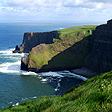ROUND TOWERS OF IRELAND
On the Trail of the Vikings
 What are those tall pointy stone towers in Ireland? Are they medieval attempts at rocket ships, like Towers of Babel to reach the stars, or a Celtic version of the pyramids? You will find them in the midst of ancient graveyards, but they are not burial monuments there for the graves. The cemeteries with their moss grown Celtic Crosses are a remnant of the ancient medieval settlements, before the Normans, and the stone towers a sign of the monastic origins of the Irish community. Ireland’s rich culture and heritage is the result of successive invasions and migrations stretching back over centuries. There was the mythical Fir Bolg, the Tuatha de Dannan – the people of the dawn, the Celts and others, adding to the individuality and cultural heritage which makes up unique Ireland character today.
What are those tall pointy stone towers in Ireland? Are they medieval attempts at rocket ships, like Towers of Babel to reach the stars, or a Celtic version of the pyramids? You will find them in the midst of ancient graveyards, but they are not burial monuments there for the graves. The cemeteries with their moss grown Celtic Crosses are a remnant of the ancient medieval settlements, before the Normans, and the stone towers a sign of the monastic origins of the Irish community. Ireland’s rich culture and heritage is the result of successive invasions and migrations stretching back over centuries. There was the mythical Fir Bolg, the Tuatha de Dannan – the people of the dawn, the Celts and others, adding to the individuality and cultural heritage which makes up unique Ireland character today.
Two recent television series have drawn upon the one of these invasions. Among the more colorful visitors to Irish shores were the Vikings. A fierce warrior people from Scandinavia who terrorized much of northern Europe for some three centuries but who also left their own indelible legacy on the countries they visited. Both “The Vikings” and “The Last Kingdom” depict the Viking arrival in the British Isles. Both of those programs focus on the Nordic conquest of England, but the Vikings play an even larger role in Ireland, and it is this story that explains the towers, the most pure basic form of a castle, dating mostly from the 12th Century.
 These ancient tourist explorers left the Norwegian fjords in search of plunder and they found it in plentiful supply in Ireland’s early Christian monastic settlements, and it is the tall round towers seen in the remains of the old settlements that remain as a symbol of the Viking incursions. The Catholic monks built the towers as castle keep strongholds with enough space for just one room at the top and no stairs to reach it. When the alarm came that the Vikings sails were sighted on the way to shore the monks would grab up their treasures and climb to the top safe room, then pull the ladder up after them.
These ancient tourist explorers left the Norwegian fjords in search of plunder and they found it in plentiful supply in Ireland’s early Christian monastic settlements, and it is the tall round towers seen in the remains of the old settlements that remain as a symbol of the Viking incursions. The Catholic monks built the towers as castle keep strongholds with enough space for just one room at the top and no stairs to reach it. When the alarm came that the Vikings sails were sighted on the way to shore the monks would grab up their treasures and climb to the top safe room, then pull the ladder up after them.
Among the favored routes of these expert seamen was the River Shannon – the longest river in either Britain or Ireland. Stretching from its estuary on the Atlantic on Ireland’s west to wind all the way to its source in County Cavan in the North East of the country and connected today to Lough Erne.
The Vikings sailed up rivers sacking villages and monasteries on the way – among them Clonmacnoise, an early Christian site founded by Saint Ciaran in the 6th century on the banks of the River Shannon, with the ruins of a cathedral, eight churches, two round towers, three high crosses and a large collection of early Christian grave slabs.
The iconic and moodily haunting settlement of Glendalough in the beautiful mountains of Wicklow is one of Ireland’s most important ancient community sites and popular tourist destinations (see Glendalough Monastic Ruins), with a stone construction houses and church buildings, while the site of the Oratory of St Declan in Ardmore (see St Declan's Well), Waterford County on the south east coast is less well known but one of the most important of early Christian sites in the south, and both offer amazing examples of these special historic artifacts. © Bargain
Travel Europe
Find best hotel and travel deals in Ireland on TripAdvisor
Web
Info
Ireland Tourism
These articles are copyrighted and the sole property of Bargain Travel Europe and WLPV, LLC. and may not be copied or reprinted without permission.
SEE ALSO:


